
Cover Sheet
Teacher Example
- Subject:
- Education
- Elementary Education
- English Language Arts
- History
- Mathematics
- Physical Science
- Social Science
- Material Type:
- Activity/Lab
- Date Added:
- 07/06/2019

Cover Sheet
Teacher Example

The attached lesson plan is designed for 3rd grade English Language Arts students. Students will analyze informational text to determine the main ideas for a report, apply the concepts of the writing process, and communicate their research through an oral presentation to their classroom peers. This lesson plan addresses the following NDE Standards: NE LA 3.1.6.e, NE LA 3.2.1.a,c,d,e,j, NE LA 3.3.1.aIt is expected that this lesson plan will take five one-hour sessions to complete.
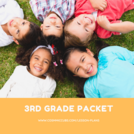
This packet assists parents and teachers transition to distance learning.
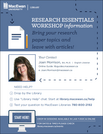
This workbook is used for library instruction for first year English courses. The model blends online tutorials, learning activies, and drop-in workshops. The learning objectives are detailed in the workbook.

Do you like eggs? Learn how to identify and write the 4 Types of Sentences while exploring the topic of chickens & eggs from a local farm in Eastern Oregon. Visuals include a powerpoint presentation (excellent online resource to use with Google Classroom) Flowchart and Thinking Map. Two types of assessments are included ( one using a sentence frame ) and challenge those who need a little more by having them write a short story.Grades 6-8

This packet assists parents and teachers transition to distance learning.

In fifth grade unit 5, Reading Historical Fiction Book Clubs, students will be organized into reading clubs consisting of 3-5 students of similar reading levels as they read historical fiction text set made up of related historical fiction, informational text and primary sources (photographs, letters, posters etc.) How do readers read, analyze and interpret historical fiction text? to understand their historical fiction and the time period connected to the text.
Summarize a written text read aloud or information presented in diverse media and formats, including visually, quantitatively, and orally. Determine central ideas or themes of a text and analyze their development; summarize the key supporting details and ideas.
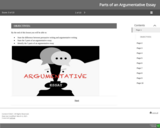
This lesson will take students through identifying the 5 parts of an argumentative essay with interactivity and a couple of Google Slides activities.

This is a 5th Grade lesson/module on Author's Point of View. This can be given to students for e-learning or taught in class with devices.
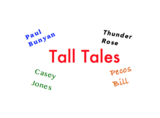
This lesson uses tall tale read alouds to reinforce the common elements, or text structure, of tall tales. As the text is read aloud, students examine the elements of the book that are characteristic of tall tales. Then using what they've learned, they write and perform tall tales of their own.
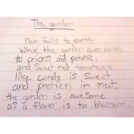
Esta es una lección para el aprendizaje a distancia que los alumnos pueden completar en casa.Los estudiantes evaluarán el impacto del lenguaje sensorial y el lenguaje figurativo en la poesía, y determinarán el significado general del poema utilizando el espacio al aire libre como contexto para la escritura.Esta actividad fue creada por Out Teach (out-teach.org), una organización sin fines de lucro que proporciona aprendizaje experiencial al aire libre, con el objetivo de transformar la educación de las ciencias para los estudiantes en comunidades más desatendidas.


The City of St. Charles R-VI School District ELA Proficiency Scale 6th Grade ELA Proficiency Scales
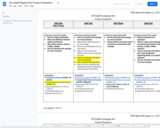
6th Grade Regular English Language Arts: Course Scope & Sequence.

Students will play a written version of the game telephone, and will determine what sorts of communication is effective with limited information, if any. This lesson is part of a media unit curated at our Digital Citizenship website, "Who Am I Online?".

This is an online module created for the 3rd Grade of the Junior High School. The topic of the lesson is the "7 Wonders of the World", and its main emphasis is placed on the Listening comprehension skills practice.The lesson is constructed on the basis of the ADDIE Model (Kurt,2017), and it is inspired by the UDL Principles approach (CAST,2011), and the Gagne's Nine Events of Instruction.During the lesson, various online platforms and webtools are used, something that makes learning procedure more interesting and accessible for all learners to attend and follow.

This is an online module created for the 3rd Grade of the Junior High School. The topic of the lesson is the "7 Wonders of the World", and its main emphasis is placed on the Listening comprehension skills practice.The lesson is constructed on the basis of the ADDIE Model (Kurt,2017), and it is inspired by the UDL Principles approach (CAST,2011), and the Gagne's Nine Events of Instruction.During the lesson, various online platforms and webtools are used, something that makes learning procedure more interesting and accessible for all learners to attend and follow.

Lesson designed for a 7th Grade ELA Deaf Education class room. Discusses the differences between fiction and non-fiction in literature as well as how to use the title and cover of the book to create an educated guess on whether the book is fiction or non-fiction. The lesson includes a learning center in which students apply what they have learned into a practice in which they organize characteristics of fiction and nonfiction into their appropriate category.
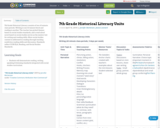
7th Grade Historical Literacy consists of two 43 minute class periods. Writing is one 43 minute block and reading is another. The teacher has picked themes based on social studies standards, and a read-aloud novel based on social studies serves as the mentor text for writing and reading skills. More social studies content is addressed in reading through teaching nonfiction reading skills and discussion.
Standards reflect CCSS ELA, Reading, and Social Studies Standards.

This mini-lesson focuses on the skill of understanding what objective and subjective writing look like and their respective purposes. Students need to be able to understand and identify objective and subjective writing in order to comprehend an author's purpose and make informed decisions about what is being conveyed in the text.